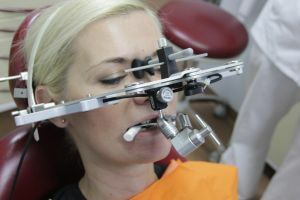 Occlusion, that is, any contact of the upper teeth with the lower ones is an individual parameter for each person. The motor features of the jaws are unique and all people are different.
Occlusion, that is, any contact of the upper teeth with the lower ones is an individual parameter for each person. The motor features of the jaws are unique and all people are different.
But at the same time this parameter should be thoroughly known in the manufacture of a dental prosthesis. Otherwise, after installation, the orthopedic structure can cause discomfort. To determine the peculiarities of the movement of the jaws, the method of diagnosing axiography( condylography) is used.
Contents of
- Contents of
- The contents of
- The structure of
- The structure of
- When to perform the procedure
- The essence and importance of
- technology Applicable devices
- Recording procedure
- Decoding results
- The contents of
We'll understand in terms of
Condylography and axiography are often perceived as different designations of one technology. However, there is a difference between them. So, condylography is a method of diagnosis, during which it is possible to study the operation of the joint and joint elements during the movement of the jaws( during chewing, speech, opening / closing the mouth).
With this method of study, a specialist is able to determine how worn the joints and their elements are.
Axiography is the process of recording a trajectory, during which the hinge axis of the temporomandibular joint moves during the movements of the lower jaw.
The difference between the two methods is the way to fix the results of the study. In the first case, the use of a computer is foreseen in the diagnosis, while the second type of examination uses mechanical recording.
Although mechanical fixation is simpler and cheaper, it is still not as accurate as electronic. In addition, the possibility of using fixed results under axiography is limited. Although occlusion data can be obtained using both methods.
Structure of the device
The axiograph is a device used to investigate TMJ movements. The electronic apparatus was called a condylograph. 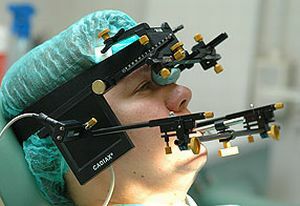
Although today the name of the electronic axiograph is more common, it consists of the following elements:
- upper arc with a nose stop attached to it;
- rubber traction;
- sites for recording the TMJ;
- lower registration arc with brackets;
- mandibular spoon;
- is a special scribe that, depending on the type of device, records the results of jaw movements on special articulatory paper or transfers the results to a computer connected to the system;
- in some cases - a video camera.
The specific components depend on the instrument and may vary. The method of fixing the information obtained depends on whether the orthopaedist uses a mechanical or electronic device.
When to perform the
procedure The device can be used in several cases. So, the axiography is used, if necessary:
- to determine the functions of the temporomandibular joint before the initiation of therapy;
- diagnose internal disorders of this joint;
- to carry out additional diagnostics, in case the previous therapy was ineffective or did not bring results at all;
- if there is a need for the use of occlusal tires or bite plates;
- to perform a surgical procedure to resolve the problem with the jaws, especially if orthopedic therapy is performed after the operation.
The technology is applied for: 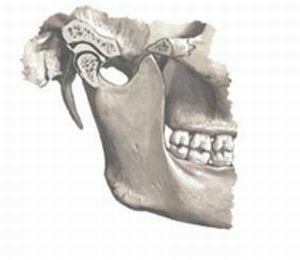
- of the exact diagnosis;
- dynamic observation during and after therapy;
- determine the cause of ineffectiveness of previous therapy of violations of the musculo-articular function;
- determining the central ratio of jaws.
Assessment of the relationship between the jaws of the patient and his teeth is impossible without knowledge of the skeletal structure of the skull. In order to obtain this information, a specialist can use a teleradiogram-a snapshot of the side of the patient's skull.
After the cephalometric calculation, the orthopedist will be able to accurately assess the situation in the oral cavity in order to increase the effectiveness of the treatment.
Essence and importance of
technology Although such a technology must necessarily be applied before prosthetics, specialists resort to its use infrequently. In most cases, this is due to the limited technical support of modern dental clinics.
But only after such a study it is possible to determine the individual features of the movement of the lower jaw. For the manufacture of a suitable prosthesis, it is necessary to have accurate data on the TMJ displacements during jaw movements in different directions.
The essence of the method is to transfer all the data recorded during the process of research to a special device - the articulator. It repeats the movements made by the patient during the diagnostic procedure. This is important for the normal modeling of the prosthetic preparations.
The data obtained during the procedure allows to create optimal designs, due to the use of which there will be no violations of occlusion. Without this information, it is difficult to create comfortable and reliable prostheses.
The device created without taking into account the results of axiography will require further correction. It will negatively affect the teeth of the patient, gradually erasing them.
In addition, the wrong prosthesis will increase the load on the temporomandibular joint. It can cause headaches, discomfort. In some cases, this circumstance leads to the development of arthrosis and arthritis of the TMJ.
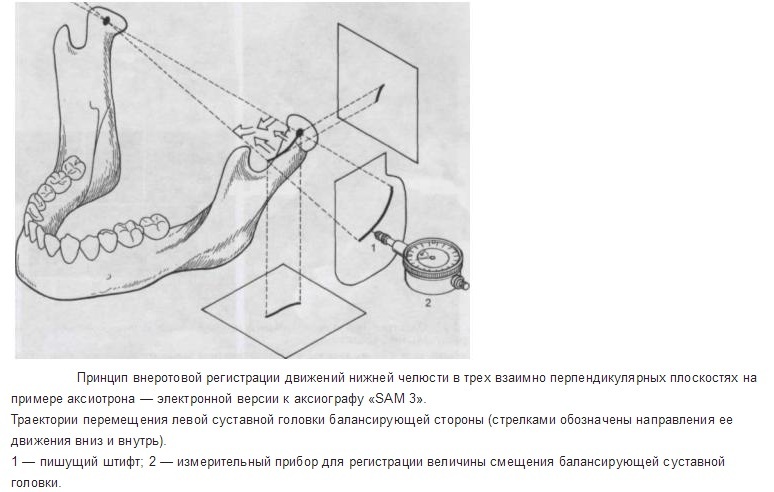
Applied devices
Advances in technology have led to the emergence of a large number of different models of devices. Isolate electrical and mechanical devices. The market has the following mechanical devices:
- Cadiax;
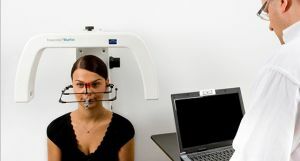
- Quick;
- Sam-3;
- Arcus Pro.
Electronic axiography is performed using the following devices:
- Free-corder BlueFox;
- Cadiax Compact;
- Arcus Digma.
Good results can be obtained by using both mechanical and electrical axiographs. However, in the latter case they will be more visible.
recording procedure The preparation for recording and the process of its creation will be considered on the basis of the French Quick device. The procedure consists of several stages:
- First, a spoon is placed with the impression mass on the lower jaw.
- Next, the upper arc is set in the Frankfurt horizontal. It is fixed with a rubber stabilizer and a nose stop. In addition, ear pellots are placed in the external auditory canals. Disks that have a millimeter division,
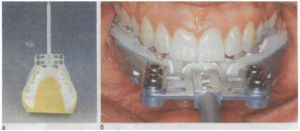
The attachment and fixation of the para-occlusal spoon
are fixed on the recording pad.
- After this, the brackets( on the spoon pin) and the scribe are mounted, which is mounted at the intersection of the lines of the paper disc.
After these manipulations, the recording of readings starts. In order to get results, the doctor will give the patient commands relating to the movements of the lower jaw. For a full result the patient will have to move the jaw in different directions, open and close his mouth, chew. - The procedure is painless, but it is recommended to perform it on an empty stomach. The impression mass in the mouth can cause unpleasant sensations and provoke a vomitive reflex. Upon completion of the recording, the specialist will decipher the results.
Decoding of results
It is possible to determine the presence of violations in the joints from the recorded paths of movements of the joints. Normal is the slope of the protrusion movements at an angle of sixty degrees( relative to the Frankfurt horizontal) during the first three millimeters of the path, with a subsequent reduction of the angle to forty degrees. Similar characteristics should have the trajectory of the mediotrusive path.
For the first five millimeters, both trajectories coincide, then there is a slight discrepancy. A sign of the presence of violations in the joint is a strong divergence of the above described trajectories.
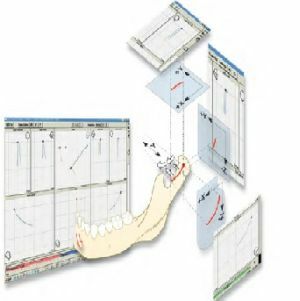
Recording movements of the jaw
Determine the presence of movements Bennett can be along the trajectories of the motion of the joints in the horizontal plane. In the normal state, the angle of inclination of the line denoting this trajectory will be from seven to ten degrees. The line itself will be straight. The presence of curvature indicates a violation.
Thus, axiography occupies an important place in the jaw prosthesis. Using this technology, a specialist can obtain the information necessary for normal jaw therapy and prosthetics. The procedure is carried out in conjunction with teleradiography and is painless.
Based on the deciphered results, the specialist will be able to fine-tune the equipment for the manufacture of prostheses, which will save the patient from adjusting them in the future. Axiography can also be used to control orthodontic therapy and before surgery.
